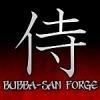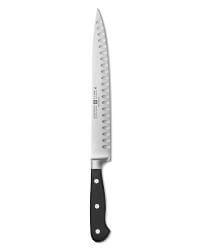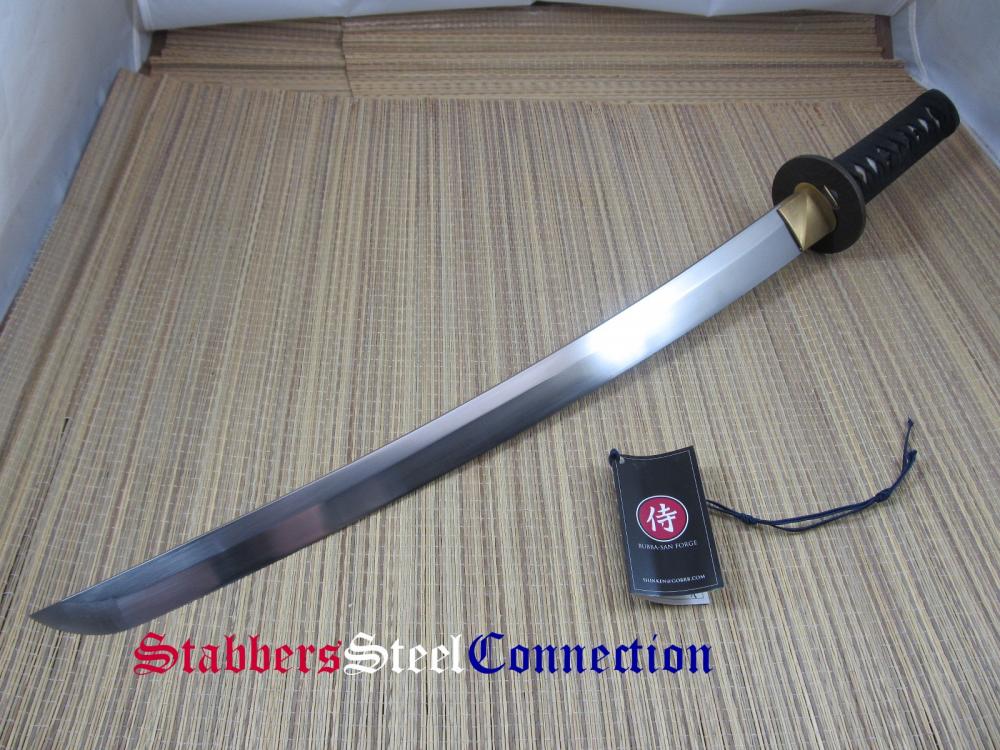-
Posts
94 -
Joined
-
Last visited
Content Type
Profiles
Forums
Articles
Gallery
Downloads
Events
Everything posted by Bubbasan
-
-
I see what you mean . Although the Hamachi is a 90 Degree angle and the munemachi is a 90 . The spine or mune is pretty soft maybe 30 - 40 rc where as the Hamachi is hardened to 60 or more .It has a lot to do with support of blade with the Habaki . I do see an occasional blade made with verticle Grooves similar to a blood groove over the complete blade . Most of those are chefs knives ( hocho) The vertical grooves are there to stop sliced food from sticking to knife . There are also cleavers made for hard chopping with same grooves . I can see additionally that grooves with uneven or irregular grooves not clean and polished could be a problem with a chopping blade. James
-
Japanese blades have 2 obvious stress risers the Hamachi and mune machi . They never break there, its always some where else . Usually the last 8- 10 In. of blade. http://www.japaneseswordindex.com/glossary.htm
-
Little late responding but, all my prayers go to those who served and to those who paid the Ultimate price . Regards James J Bieler USN retired Vietnam 1964 - 1967
-
I make some jewelry and make alloys of gold and silver. for sword fittings
-
On water quenched blades , I try for about 1/10 on the ( edge) Oil quench not so thick . A dime is a good thickness
-
-
Nice looking bunch blades .5160 is some very tough steel . If it's nice and thick on big Seax I don't think there will be much problem as long as temper is good. James
-
Wow , thank you fellas for the kind words . I am grateful for the honor to meet a great bunch of hammerheads . Respectfully James
-
Hello folks how have you been ? I have been very ill . I was in Japan for a visit and I contracted an unknown genotype of Hep" C" I was in Military hospital in Okinawa for several months . Currently I am taking the very latest medicine to fight it . Sovaldi and olisio Feeling much better although, I still have 2 months of treatment left . I will post up some new Tamahagane blades I forged and polished .after I feel better. I am about 50% right now . Hope everyone is doing well . James Bieler USN Retired
-
wow what a nice blade , I am very impressed, no pun intended........ James
-
Here is billet we made last year from several meteorites we found in Arizona or colorado I cant remember . It made nice billet. I now know it was from Arizona near tuscon. weight is over a lb. with handle of mild steel, does not include weight of smaller one . Was thinking about some sanmai or damascus . I have never forged anything from a meteor. We had no problem making billet , went real slow , I imagine its like forging some wootz ,,,,, real slow . The smaller one is 8 oz. ....... James .
-
Nice blade , big and sturdy ... I like it .... james
-
about 1 foot tall , we tear them down after using them . I think its easier . It was about 5' ft tall and 1.5' wide tapering toward the bottom. James I use fire brick I get from a chimney maker so its not a brick / money issue. James
-

Blacksmithing gems and pearls
Bubbasan replied to Glenn's topic in Blacksmithing, General Discussion
Hey owen , might as well , ugly is ugly . But, I have a few ugly tongs I still like to use .... james -
The ore was from Japan , (Black sand ore) Via Dick tools from Germany . For some reason They will sell to Germany via special licence? .But not to USA ? I think the ore was sold to dick tools by Japanese tool maker , who is licenced to bring it here . There is a company in California, Hida tools who make plane blades from tamahagane , They wont sell any Tamahagane kera . I asked them many times . My buddy and I smelted it our tatara in missouri . we added a little magnatite for grins ..... James It was a pain!
-
I used to buy powdered nickel in a barrel , its high though. works like previous poster said for contrast . Its the only metal that when alloyed properly it it used in the turbine props on jets . Only alloy that can withstand heat of 3000f for 16 hrs without warping . I saw this on TV nat Geo ... I was surprized nickel was that tough .... James
-
I have been doing research on the alloy . It has been used in coins during early roman days . I believe it was discovered accidently ? Because I think silver and copper are sometimes found together naturally , as does gold and copper . I imagine some old miner in days of old, found or dug some and decide to hammer it . walla shibuichi . Although probably not in the 40/ 60% formula ? that the japanese use today. The mines in taxco, Mexico some of their silver has quite a bit of copper in it .Has to be refined to remove copper . James
-
I have some smaller blades coming , more like skinners , and utility and edc blades . 3 -4 different types . All tamahagane .exotic wood handles they are just ugly bare blade now rough forged and ground a little . I will attempt to clay and quench them , see what happens . Oil usually is not a hard enough quench to get good hamon on this steel. It takes a great hamon . Water is the best . with smaller blades you dont have to worry about cracking too much with water when small . All I do is 4-5 seconds in water , Just depends on blade size . Because of differential ht you only temper at 300f for 1/2 hr . When doing swords quench is a little longer , temper is when blade get to 300 f for short time ..... 5-10 min. The reason is spine is already about 40 rc where as the edge is 61 0r so .If you do standard mono steel temper , it will damage Hamon and make spine too soft .Longtr tempers and hamon may be there but not bright and sunny. Heat is the biggest enemy of a good hamon ...... Thanks for comments I appreciate......James
-
Come on up Mate , got plenty room .........
-
It can be tough , because tsuka is kind of hour glass shaped. Just make sure you soak in water real good and make it flexible . put on glue stretch real tight . Over lap, let it dry and cut off excess material .That's the hard part actually. James
-
couple more pics of finished tanto with horimono.
-
Hello , the blade is a small naginata/ nagamaki just has longer tsuka ( handle) started with 1-75 layer billets folded 13 times . so it had 75 layers to start layers to start . If you fold it 14 times you get 1,228, 800 layers .This practice was common in order to work out the impurities in the steel. there are Japanese swords that have up to several million layers . I do mine with saymak hammer , The japanese did it with hammer teams of up to 4 men hammering at the same time in sucession . has a wierd Rhythm when you listen . There is usually master smith with a little stick pointing to where they want you to hit .I also have a large kiridashi and knives made from same billet . Let me find them. wait one . most of the pics are not super close ups . If you look at fold lines it appears to have normal amounts of folds . But, between those are hundreds of very fine fold lines . On the tanto with horimono you can see a little better . I have 1000's of pics it takes a while to find them working on some CPM 3-V swords made like shinogi zukuri blade , no hamon but super tough cutters as good or better than Infi by busse swords. I will post some more pics later as I am not feeling well on some stem cell treatment for a bad liver ... thank for looking James
-
I recently read an article from Smithsonian , The article says the Japanese visited South america and learned from the indigenous people to make alloy of silver/ copper a type of bronze (shibuichi) and later adapted it for sword fitting s. Can anyone shed any light on this .I do know they visited them at monte Verde in ancient times . any info would be helpfull thank you .......James
-
I just finished this ( almost ) need to cut a saya ( Scabbard) made for 1,200,000 layer tamahagane . outfitted with antique japanese fuchi ( handle support ) with (solid fine silver) tsuba .Changed it to silver one Also has white rayskin cover and black buffalo horn Mekugi ( pin ) has nice engraving ( horimono ) and black buffalo horn Kashira ( pommel) I hope you like it james


